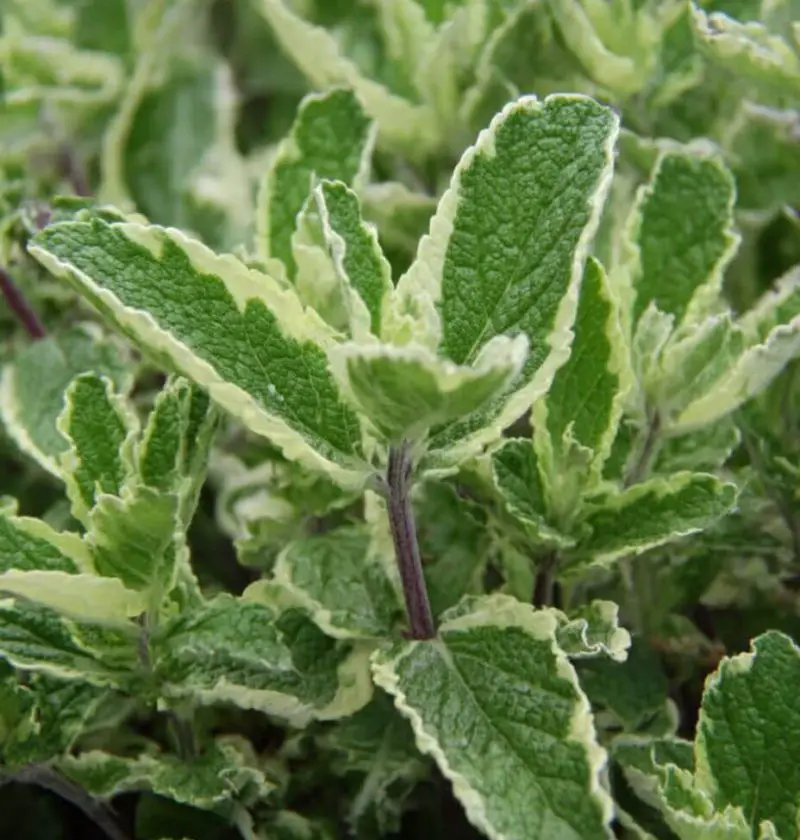Save This Recipe
You know how some folks get carried away with tomato plants every spring? That’s me with mint.
Now, we all know the usual suspects—peppermint, spearmint… maybe even that lanky store-bought mint that wilts before you get home from the grocery store. But there’s a whole mint universe out there beyond what most of us grew up with. And let me tell you, it’s weird, it’s wonderful, and yes, I’m a little obsessed.
So if your garden could use a bit of charm, some good smells, or just something new to fuss over this season, let’s talk mint. Here are 9 unusual varieties that’ll surprise you in the best way.
1. Pineapple Mint – Yes, It’s as Cute as It Sounds
Grows in: Zones 5–9
This one’s a stunner. Its leaves are splashed with creamy white, and when you rub it, it smells faintly like pineapple gum—remember that stuff from the 80s? Yeah.
It’s great in fruit salads, iced tea, or just for looking pretty along the edge of the patio. Plus, bees love it. And we love bees.
2. Mojito Mint – Summer in a Leaf
Also called: Cuban Mint
Grows in: Zones 5–9
If you’ve ever tried to make a mojito at home and thought, “Why doesn’t this taste like it did on vacation?”—this is your answer. Mojito mint is the real deal. It’s gentler, less sharp than peppermint, and has this mellow, fruity thing going on.
Even if you don’t drink, it’s delicious in sparkling water with a squeeze of lime.
3. Corsican Mint – The Ground Hugger
Grows in: Zones 6–9
Now here’s a little fella. Tiny leaves, big fragrance. It grows low and wide—perfect between stepping stones or along garden paths. Step on it, and you’ll get a lovely minty waft in the breeze.
It’s not showy, but it quietly steals the show. I planted it between bricks one year and it hasn’t stopped making me smile since.
4. Curly Mint – Like Spearmint with a Perm
Grows in: Zones 5–9
This one’s just fun. The leaves twist and curl like they’re headed to a garden party. It’s a type of spearmint, so it tastes familiar, but it looks totally different.
If you’ve got kids or grandkids, they’ll love how “fancy” it looks. Mine kept asking if it was lettuce that got scared.
5. Wild Mint – Born to Be…Well, Wild
Grows in: Zones 4–10
This is the mint you’ll find growing in the woods, along fields, or next to an old fence in the country. It’s got a slightly stronger bite than your store-bought mint, and the leaves and stalks often have a bit of purple going on.
Great in teas, and perfect if you like your herbs with a little attitude.
6. Watermint – Marsh Queen
Grows in: Zones 3–10
This mint doesn’t mind getting its feet wet—literally. Plant it near a pond or birdbath and it’ll be right at home. It’s got a deep, almost sharp scent that clears your head like nothing else.
I stuck some in a leaky corner of my garden bed last year and it’s just thriving. Didn’t even ask for much.
7. Pennyroyal – The Pest Police
Grows in: Zones 5–9
Okay, real talk: don’t eat this one. Seriously. It’s not food-safe.
But it smells super strong, and bugs hate it. Like, really hate it. The Romans used to smear it on themselves to keep fleas away. Early settlers used it to scrub down tables and hang in doorways to keep out flies.
I dry mine and stuff it in little cloth sachets for my porch furniture. Works like a charm.
8. Chocolate Mint – I Swear I’m Not Making This Up
Grows in: Zones 5–9
Yes, it smells like chocolate. Yes, it really does. Some say it’s more like chocolate-orange or chocolate-mint gum, but either way—it’s weird and wonderful.
Toss some in your hot cocoa or bake it into brownies. You’ll feel like a garden witch and your kitchen will smell amazing.
9. Apple Mint – Soft, Sweet, and Old-Fashioned
Grows in: Zones 5–9
This one’s fuzzy. Like, soft enough to pet. It smells lightly fruity—think crisp apple mixed with mint—and looks more delicate than other types. I like using it in herbal teas or infusing honey with it (just stick a few sprigs in the jar and wait a week).
Even if you don’t end up using it much, it’s just lovely to have around.
A Little Mint Wisdom from Someone Who Learned the Hard Way
Plant your mint in containers. Trust me. It spreads faster than gossip at a church potluck. One year I stuck peppermint straight into a flower bed and by August it had taken out the marigolds, the thyme, and was eyeing the tomatoes.
You can plant it in the ground if you bury a pot to keep the roots contained—but if you’re a “set it and forget it” kind of gardener, stick with raised beds or patio pots.
Mint loves sun, doesn’t mind part shade, and once it’s settled in, you’ll have fresh leaves from spring till frost. It’s forgiving, fast-growing, and smells better than half the air fresheners on the market.
Final Thought (From My Garden to Yours)
Mint isn’t just for tea or gum or holiday desserts. It’s a joy to grow. It’s nostalgic, it’s useful, and when you find those special varieties that surprise you—like chocolate or pineapple? Well, it makes gardening feel a little bit magical again.
So maybe try something new this season. Plant a mint that makes your friends go, “Wait…what’s that smell?”
And when they ask if you really needed one more type of mint, you just smile and say, “You bet I did.”

